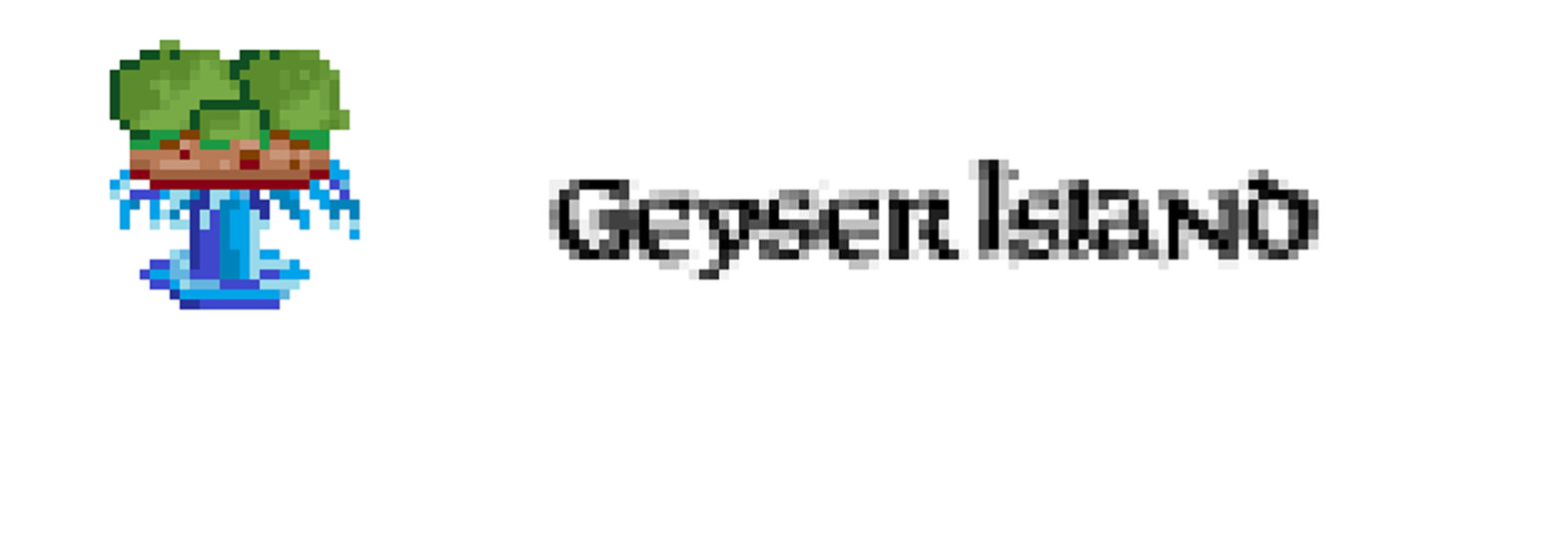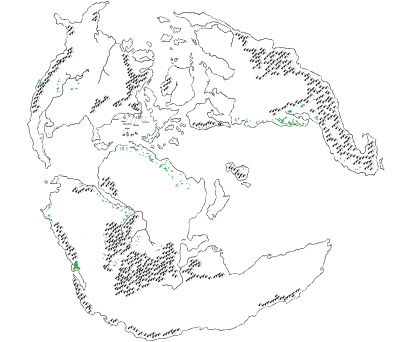
Geyser Bouncer Islands on Mystara
by RobinThis is the research Compilation of the Geyser Bouncer Islands originally created by Frank Hampson and Don Harley for the 1955 created comic of Dan Dare The Man from Nowhere. :shock:
This is compiled by me for the research to enable these islands to become a Mystara D&D feature, The results of this research is explained below.
This is soo new, and different this symbol requires a full explanation. I did already create this decades ago (august-1983) in my oldest maps; The island West of The Isle of Dread.
Yet this mystical wonderful location deemed to have a spot on Mystara in my opinion, and now in full details. :o
First the new Hex Symbol
It can now be found on my updated Legend under the column of volcanic symbols

Compiling the textual information within the comic on this natural phenomenom and the Mystara/Megalith statistics together we can ascertain the following aspects.

1; Unlike Natural Geysers these do not consist of pressurized hot water (and some air), but actually the reverse; Pressurized Air and some water. As according the comic text; "Natural gas has blown a section of the territory free of the surrounding jungle".
Conclusion 1; there must be a continuous creation of Air below the surface.
Conclusion 2; the surface must contain of a stone and claylike mass sticky enough to cling together making it air tight, and strong enough to resist immense amounts of air under high pressure. The mentioning of a jungle suggests also a root/mycellial roor system strengthening the clay/earth areas, and a limitation to the size of these Geyser islands.
Conclusion 3; This air pressure combined with the surface material is strong enough to eventually cause a circular break of the surface of 100 to 400 yards (100+3d100) diameter. These circular breaks (according the comics text) are so close that the 'safe' areas in between are small. This means that the whole area is dotted with circular areas and intermediate 'safe' areas (safe is a insignificant word, as when a closeby circle becomes an active Geyser Bouncer Island or an Ait Geyser, close proximity is still dangerous.
Conclusion 4; When the pressure decreases the Islands slowly sinks again into the hole is came from, its weight and stickyness now causing a clinging together again making it anew airtight.
2; The gass is harmless, and its force rarely lasts more than 7 days
Conclusion 5; The harmless gas/air is coming from at least one (more logical many more) exiting Gates from the Plane of Air underneath the ground. This is suggested in the Gold Box and several Fanon sources where the Megalith builds up itself over millenia by using exiting gates from the Elemental Planes. Water, Magma, and Fire all have logical locations (Worldshield(Fire-Volcanoes), in the core around the Worldshield(Earth), on and in the surface (Water) as per diverse canon/fanon Mystara sources, yet Air has not been really detailed on its location. Within the sky would seem initially logical (as in respect to air itself) yet does not comply with the biological sense of the Megalith. It would need to have any of the Elemental gates within or on itself.
Conclusion 6; The description and images seem to describe a depression of some sort. The above conclusions suggest an orginal thick layer of clay. Clay is formed underwater only. Which suggests the area had been submerged. This would explain the moisture in the atmosphere, creating a climate. Rain and erosion would cause the air gates to become flooded and clogged. Within a short time these gates were covered in a increasing amount of loose sediment, clogging together under water. The Air Gates thus were not closed, but clogged. (in the Plane of Air it would explain Earth-Air Elemental tensions as at least some of this mud would enter that Plane and creating the base for Elemental Planar Floating Islands).
Conclusion 7; The combined pressure due the closed Gate and the clogginess of the clay with the weight of the earth/stone on top give a variable timing of floating and release of these Geyser Islands. Rarely more than 7 days as according the Comic source gives an estimate maximum of 200 hours and thus a variable of 20d10 hours.
The clay/clogginess an estimate minimum of 20d20 days between an islands settling in the ground and rebursting.
3; The illustration not only suggests Geyser Islands but also Air Geysers without an Island.
Conclusion 8; On several Locations the Vegetation has grown together with its root systems around a gate and prevents an area to release. However, these locations will also eventually rupture in a somewhat star-shaped fashion, tearing the roots apart, tossing the edges up and aside, and give an air geyser with a smaller diameter and higher height. The estimates taken from the Comic art suggest these being 25% of the Geyser Islands thus no more than 100 yards in diameter (estimates 10d10 yard). These will also last shorter (estimate 25%=5d10 hours).
Conclusion 9; The islands are pushed up roughly at equal height (air Geysers without an Island 20% higher). I have estimated the Geyser islands based on the characters displayed at 300 to 500 yards (300+2d100).
Conclusion 10; These Islands haver a thickness of about 40 to 80 Feets (40+2d20)
Conclusion 11; Along the islands the air spreads out causing an updrsaft and difficult to control airmovements, causing Flyers to make Control checks several times or else be blown 100+2d100 feet further up and plummeting down further away if not regaining control (See DotE about Flying and control).
4; According to the comic text; Locals have devised detection wands giving early warnings of an Eruption of a Geyser Bouncer. These resemble A common water-divining stick. Otherwise it is unknown when such a geyser will erupt until the very last moment.
Conclusion 12; These wands detect either an increase of Air Below the ground or the minute termores of pressure buildup. Eitherway if used they will suddenly point up when an area is revealing to go to burst soon. The text suggest it will take little time, giving an estimate of 20+2d10 rounds before a burst. Local Animals will also sense this before and depending on their biological needs may move away or on the Geyser Island. The last 10 rounds there will be noticeable tremors to all on or close to the geyser (40 yard).
Conclusion 13; Standing within 40 feet to a bursting Geyser will cause 4d8 impact damage from bursting mud/earth, falling mud/earth and the blast of air itself. This damage will be within 40 feet of the geyser at moment of eruption and landing directing outward (both lasting an hour=6 Turns), and continue within 5 feet of the geyser while erupting. Jumping into the Geyser is instant death by the airblast, dispersal into the island and then falling down.
Conclusion 14; For easy handiness to a DM each Turn walking in an Geyser Island area will have a 1 on 1d20 chance of a surface to erupt within 1 Turn (giving the PC's/NPC's a chance to evade, following the Above timing.) Within 400 yards of an already erupting Geyser no new geyser will erupt, util is has landed.
So combined we have the following game results;
Encountered in depressions which were formerly a muddy lake. Mostly fast growing Tropical/Subtropical vegetation/climate, with high degree of moisture and clay ground
One location known as per my oldest maps; The island West of The Isle of Dread
Other general Locations suggested; Jungle North of Davania, Jungle South of Skothar, Ochalea, Thanagioth archipelago (only a few)
Here a Mystara map with said location marked in green;

The area is Thin Jungle in normal movement statistics and getting lost rolls. Some sections will be heavy Jungle, but these are allways in the middle of each Geyser Bouncer Island or at the edges of the area where these Geyser Bouncer Islands do exist.
1 on d20 chance to erupt within 1 Turn.
20+2d10 rounds before detectable by divining rod
10 rounds noticeable by increasing minor tremors within 40 yard
If any non-elemental flying creature tries to enter gat blast itself;
As Air Elemental creatures are based on the Element escaping here. they will certainly have been exposed to the forces. Which may be strong, yet these elemental Creatures would instinctivly find a way to 'sail' a way back against the force, especially as parts of this force can go through the creature.
Non-elemental creatures do posess other elements disabling this 'going-through-the -creature' and will be pushed out, with tremendous fore, as resistance= force and becomes movement and damage.
As such I suggest an 2d8 airblast damage each round within the geyser and being propelled up to the island directly suffering 2d8 impact damage there. then pushed outside uncontrolled and becoming exposed to the updraft and possible falling if losing control (make control checks with the sustained damages as penalty). Together mostly this will result in material damage and death, and be deposited somewhere around the island. Natural flying creatures will sense the strength of the airblast and will not come closer, except if surprised during the air geyser's (without an island) initial spawningtime. That means some birds and such could be found dead next to these air geysers.
If flying above Geyser Island Bouncers while not being air-elemental during the sudden rise up they will be forced up with the air and suffer only mildly, some vulnerable creatures might die from impact on the island, yet most will be in the compresses pre-existing air on the island and may only be forced to the island's surface. I suggest a save and flying check to prevent any impact damage in these rare circumstances a flyer is above an island on its spawning moment. Any impact damage would be like falling damage. so if 30 yards above the island and failing both save and flying check would sustain then the damage for 30 yard=90 feet.
Within 40 feet to a bursting or landing Geyser will cause 4d8 impact damage from bursting/falling mud/earth and air blast
Within 5 feet to a erupting Geyser will cause 4d8 impact damage from bursting/falling mud/earth and air blast
On the island while bursting up a Dexterity check is required to prevent falling prone.
On the island while Floating requires no dex check to move or stand, yet minor tremors can be felt.
On the island the edges are too unstable to climb, and might cause a fall.
Roots held might prevent falling for as much rounds as Strength holder.
Geyser Islands are 40+2d20 feet Thick, 100+3d100 yard diameter and pushed up 300+2d100 yards, lasting 20d10 hours
Around the Islands is an Updraft causing each round Flying control checks or else be blown 100+2d100 feet further up and plummeting down further away if not regaining control (See DotE about Flying and control).
Air Geysers (without an Island cause the same effects, and are 10d10 yards in diameter, lasting 5d10 hours, elevating 300+2d100 yards +20%
After settling no new burst within 20d20 days
The last 6 Turns of activity the Geyser or Geyser Island will lower with 15% each turn, and then the weight of the matter will plummet in its corresponding original hole, clinging together there.
Due to the connection with the Plane of Air there is a 5% chance to encounter an Air Elemental Creaure (use wandering Monster table as per Plane of Air). Air Elemental Creatures are the Only ones capable of entering the Geyser and returning to the Plane of Air.
The only way for an creature of mixed elements and not pure air elemental state, is to assume an immaterial state AND having a immaterial flying state AND succeed a flying skill at -8, if this fails the creature will be unable to enter and suffers 2d8 airblast damage and is expelled.
I hope you all will like this additional feature to Mystara